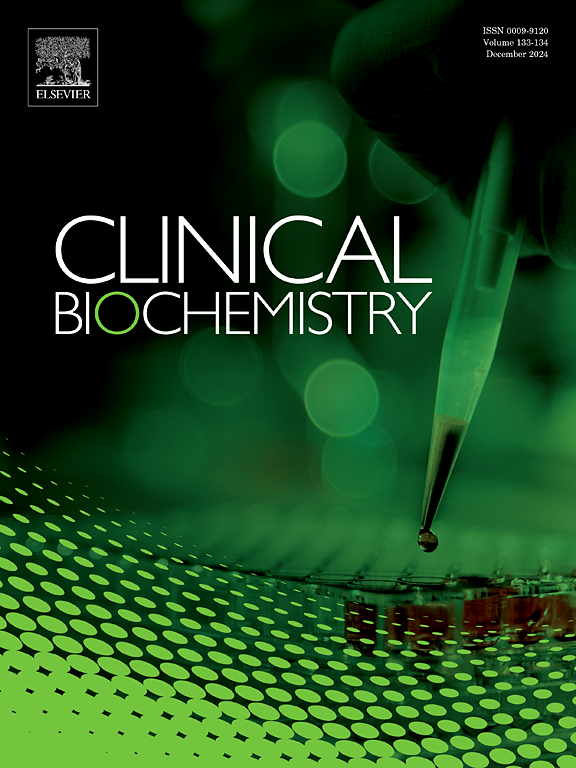Impact of age on cardiac troponin concentration among healthy individuals
IF 2.1
3区 医学
Q2 MEDICAL LABORATORY TECHNOLOGY
引用次数: 0
Abstract
Background
The 99th percentile of cardiac troponin (cTn) among healthy individuals is the diagnostic cutoff for myocardial infarction. This study investigates the effect of age on the 99th percentile of cTn among healthy individuals.
Methods
We sampled healthy Danish blood donors, screened using hemoglobin A1c, N-terminal pro-brain natriuretic peptide, and creatinine. The cTn assays investigated were Siemens Atellica and Dimension Vista hs-cTnI, Abbott hs-cTnI, Vitros hs-cTnI, and Roche hs-cTnT. The 99th percentiles were calculated using the non-parametric method and modeled using quantile regressions adjusted for sex and creatinine concentration.
Results
We included 2287 participants, excluding 118 due to a history of heart disease, insufficient plasma, or biomarker screening, leaving 2169 participants with a median age of 58 years (IQR 49–69 years), and 1152 (53 %) were female. Concentrations increased with age for all assays (p < 0.001). Only the 99th percentile of hs-cTnT was significantly associated with age (0.42 ng/L increase/year, p < 0.001); for participants >70 years, the 99th percentile was 36.8 ng/L (90 % CI 33.8–40.7 ng/L), with 22.2 % above the manufacturer’s 99th percentile. The difference in the 99th percentile between age groups was less clear for cTnI, except for the Vitros assay: <50 years 6.5 ng/L (90 % CI 5.0–26.9 ng/L) vs >70 years 17.3 ng/L (90 % CI 9.7–33.2 ng/L).
Conclusions
Age was associated with increased cTn concentrations for all assays. The correlation was strongest for hs-cTnT, where the 99th percentile for participants >70 years was more than double compared to those <50 years, with over 20 % exceeding the manufacturer’s 99th percentile.
Registration
URL: https://www.clinicaltrials.gov; Unique identifier: NCT05336435.
年龄对健康人心肌肌钙蛋白浓度的影响
健康个体心肌肌钙蛋白(cTn)的第99百分位数是心肌梗死的诊断分界线。本研究探讨年龄对健康个体中第99百分位cTn的影响。方法选取健康的丹麦献血者,采用糖化血红蛋白、n端脑钠肽前体和肌酐进行筛选。cTn检测包括西门子Atellica和Dimension Vista hs-cTnI、雅培hs-cTnI、Vitros hs-cTnI和罗氏hs-cTnT。第99个百分位数采用非参数方法计算,并采用分位数回归模型对性别和肌酐浓度进行校正。结果我们纳入了2287名参与者,排除了118名因心脏病史、血浆不足或生物标志物筛查的参与者,留下2169名参与者,中位年龄为58岁(IQR为49-69岁),其中1152名(53%)为女性。所有检测的浓度都随年龄增长而增加(p <;0.001)。只有hs-cTnT的第99百分位与年龄显著相关(增加0.42 ng/L /年,p <;0.001);对于70岁的参与者,第99百分位数为36.8 ng/L (90% CI 33.8-40.7 ng/L),比制造商的第99百分位数高22.2%。cTnI的第99百分位数在年龄组之间的差异不太清楚,除了Vitros试验:50岁6.5 ng/L (90% CI 5.0-26.9 ng/L) vs 70岁17.3 ng/L (90% CI 9.7-33.2 ng/L)。结论sage与cTn浓度升高相关。hs-cTnT的相关性最强,70岁参与者的第99百分位数是50岁参与者的两倍多,其中超过20%的参与者超过制造商的第99百分位数。RegistrationURL: https://www.clinicaltrials.gov;唯一标识符:NCT05336435。
本文章由计算机程序翻译,如有差异,请以英文原文为准。
求助全文
约1分钟内获得全文
求助全文
来源期刊

Clinical biochemistry
医学-医学实验技术
CiteScore
5.10
自引率
0.00%
发文量
151
审稿时长
25 days
期刊介绍:
Clinical Biochemistry publishes articles relating to clinical chemistry, molecular biology and genetics, therapeutic drug monitoring and toxicology, laboratory immunology and laboratory medicine in general, with the focus on analytical and clinical investigation of laboratory tests in humans used for diagnosis, prognosis, treatment and therapy, and monitoring of disease.
 求助内容:
求助内容: 应助结果提醒方式:
应助结果提醒方式:


